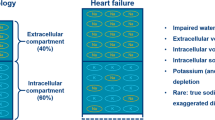Abstract
Furosemide is one of the most common drug used to treat anasarca in childhood nephrotic syndrome. It has minimal side effects on short-term usage, but prolonged use can result in polyuria, hypokalemia and metabolic alkalosis. This pseudo-bartter complication can be treated by discontinuation of the drug with adequate potassium replacement. We report a child who was given furosemide for 20 days elsewhere to treat the edema due to nephrotic syndrome and then presented to us with bartter-like syndrome. Furosemide was discontinued and potassium replacement was initiated. However, the child continued to have polyuria leading to repeated episodes of hypotensive shock. In view of severe symptoms, she was given a short course of oral indomethacin for 6 days, to which she responded. This case highlights the fact that indomethacin can provide symptomatic improvement in furosemide induced pseudo-bartter.

Similar content being viewed by others
References
Keller E, Hoppe-Seyler G, Schollmeyer P. Disposition and diuretic effect of furosemide in the nephritic syndrome. Clin Pharmacol Ther. 1982 32(4):442–9.
Rane A, Villeneuve JP, Stone WJ, Nies AS, Wilkinson GR, Branch RA. Plasma binding and disposition of furosemide in the nephritic syndrome and in uremia. Clin Pharmacol Ther 1978; 24(2):199–207.
Colussi G, Rombolà G, Airaghi C, De Ferrari ME, Minetti L. Pseudo-Bartter’s syndrome from surreptitious diuretic intake: differential diagnosis with true Bartter’s syndrome. Nephrol Dial Transpl. 1992;7:896–901.
Numabe A, Ogata A, Abe M, Takahashi M, Kono K, Arakawa M, Ishimitsu T, Ieiri T, Matsuoka H, Yagi S. A case of pseudo-Bartter’s syndrome induced by long-term ingestion of furosemide delivered orally through health tea. Nihon Jinzo Gakkai Shi. 2003;45:457–63.
Vasudevan A, Mantan M, Bagga A. Management of edema in nephrotic syndrome. Indian Pediatr. 2004;41(8):787 – 95.
Schepkens H, Hoeben H, Vanholder R, Lameire N. Mimicry of surreptitious diuretic ingestion and the ability to make a genetic diagnosis. Clin Nephrol. 2001;55:233–7.
Ruisz, et al. Furosemide-induced severe hypokalemia with rhabdomyolysis without cardiac arrest. BMC Women’s Health. 2013;13:30.
Unwin RJ, Capasso G. Bartter’s and Gitelman’s syndromes: their relationship to the actions of loop and thiazide diuretics. Curr Opin Pharmacol. 2006;6:208–13.
Kammerl MC, Nüsing RM, Richthammer W, Krämer BK, Kurtz A. Inhibition of COX-2 counteracts the effects of diuretics in rats. Kidney Int. 2001;60(5):1684–91.
Sasaki H, Kawasaki T, Yamamoto T, Ninomiya H, et al. Pseudo-Bartter’s syndrome induced by surreptitious ingestion of furosemide to lose weight: a case report and possible pathophysiology. Nihon Naibunpi Gakkai Zasshi. 1986;62(8):867–81.
Sasaki H, Okumura M, Kawasaki T, Kangawa K, Matsuo H. Indomethacin and atrial natriuretic peptide in pseudo-Bartter’s syndrome. N Engl J Med. 1987;316(3):167
Seyberth HW, Koniger SJ, Rascher W, Kuhl PG, Schweer H. Role of prostaglandins in hyperprostaglandin E syndrome and in selected renal tubular disorders. Pediatr Nephrol. 1987;1:491–7.
Funding
None.
Author information
Authors and Affiliations
Corresponding author
Ethics declarations
Conflict of interest
All authors declare that they have no conflict of interest.
Research involving human participants and/or animals
Due permission from the Departmental Review Board was taken.
Informed consent
Taken.
About this article
Cite this article
Varma, T.H., Sharma, A., Santhiya, S. et al. Furosemide-induced tubular dysfunction responding to prostaglandin synthesis inhibitor therapy in a child with nephrotic syndrome. CEN Case Rep 7, 195–197 (2018). https://doi.org/10.1007/s13730-018-0324-3
Received:
Accepted:
Published:
Issue Date:
DOI: https://doi.org/10.1007/s13730-018-0324-3




